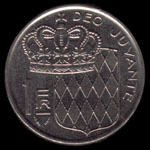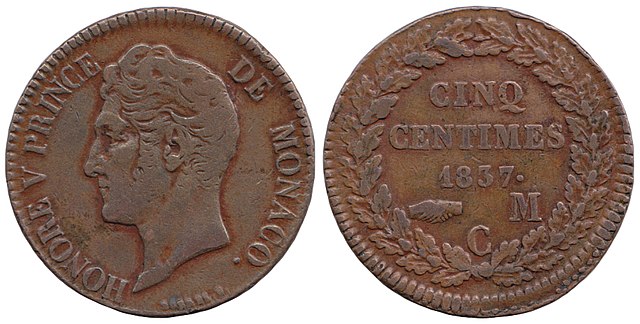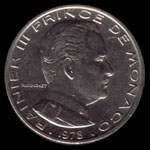Monégasque franc
Currency of Monaco before 1995 From Wikipedia, the free encyclopedia
The franc (unofficially MCF) was the official currency of the Principality of Monaco until 1995 (de facto, 1996 de jure), when it changed to the French franc which was replaced by the euro in 2002.[1] The franc was subdivided into 100 centimes or 10 décimes. The Monégasque franc circulated alongside the French franc with the same value. Like the French franc, the Monégasque franc was revalued in 1960 at a rate of 100 old francs = 1 new franc.[2] The official euro-to-franc exchange rate was MCF 6.55957 to EUR 1.[3]
This article needs additional citations for verification. (September 2011) |
| franc monégasque (French) | |
|---|---|
 1978 1 Monégasque franc (reverse) | |
| ISO 4217 | |
| Code | None (MCF unofficial) |
| Unit | |
| Symbol | fr. or F |
| Denominations | |
| Subunit | |
| 1⁄100 | centime |
| Coins | 1, 5, 10, 20, 50 centimes, 1⁄2, 1, 2, 5, 10, 20 francs |
| Demographics | |
| User(s) | None, previously: Monaco, France, Andorra |
| Issuance | |
| Mint | Monnaie de Paris |
| Website | www |
| Valuation | |
| Pegged with | French franc at par |
| This infobox shows the latest status before this currency was rendered obsolete. | |
Today, Monégasque coins have only numismatic value, including the fleurs de coins, or proof-like coins. The period for exchange of the coins for euros has expired.
The Monégasque franc was legal tender in Monaco, France and Andorra.
Coins
Summarize
Perspective
Monaco's first decimal coins were issued in 1837 and 1838, in denominations of 5 centimes, 1 decime and 5 francs. The 5 centimes and 1 decime were minted in both copper and brass and were the same size as the earlier French coins (France was not minting these denominations at the time) whilst the 5 francs matched the French coin. No further issues were made until 1879,[4] from when gold franc coins were issued until 1904.[5]

Between 1924 and 1926, aluminium-bronze 50 centimes, 1 and 2 francs were issued of the same size as the French coins. In 1943, aluminium 1 and 2 francs were introduced followed by aluminium-bronze versions in 1945, alongside aluminium 5 francs. In 1946, cupronickel 10 francs were introduced, followed by 20 francs in 1947, a coin to which there was no corresponding French coin. In 1950, aluminium-bronze 10, 20 and 50 francs and cupro-nickel 100 francs were issued, with the size of the 100 francs reduced to match the French coin in 1956.
When the franc was revalued in 1960, Monaco issued nickel 1 franc and silver 5 franc coins. In 1962, aluminium-bronze 10, 20, and 50 centime coins were added, followed by nickel 1⁄2 franc coins in 1965, nickel-clad cupronickel 5 francs in 1971, nickel-brass 10 francs in 1974, stainless steel 1 centime and aluminium-bronze 5 centimes in 1976, bi-metallic 10 francs in 1989, and tri-metallic 20 francs 1992, respectively. All of these coins matched the sizes and compositions of corresponding French coins.
| Coins of the Monégasque franc ("Old franc (Ancien franc) issue") | |||||||||
|---|---|---|---|---|---|---|---|---|---|
| Image | Value | Technical parameters | Description | Date of first minting | |||||
| Diameter | Thickness | Mass | Composition | Edge | Obverse | Reverse | |||
| 50 centimes | 18 mm | 2 g | Aluminum-bronze | Reeded | Crowned monogram of Louis II, Hercules with bow | Sword, coat of arms of the House of Grimaldi | 1924 | ||
| 1 franc | 23 mm | 4 g | Aluminum-bronze | Reeded | Crowned monogram of Louis II, Hercules with bow | Sword, coat of arms of the House of Grimaldi | 1924 | ||
| 1 franc | 22.9 mm | 1.5 mm | 1.3 g | Aluminum | Smooth | Louis II | Coat of arms of Monaco | 1943 | |
| 1 franc | 23 mm | 1.55 mm | 4 g | Aluminum-bronze | Smooth | Louis II | Coat of arms of Monaco | 1945 | |
| 2 francs | 27 mm | 2 mm | 2.25 g | Aluminum | Smooth | Louis II | Coat of arms of Monaco | 1943 | |
| 2 francs | 27 mm | 2 mm | 8 g | Aluminum-bronze | Smooth | Louis II | Coat of arms of Monaco | 1945 | |
| 5 francs | 31 mm | 2.4 mm | 3.7 g | Aluminum | Smooth | Louis II | Coat of arms of Monaco | 1945 | |
| 10 francs | 26.1 mm | 1.8 mm | 7 g | Copper-nickel | Reeded | Louis II | Coat of arms of Monaco between olive sprigs | 1946 | |
| 10 francs | 20 mm | 1.5 mm | 3 g | Aluminum-bronze | Smooth | Rainier III | Crowned shield, text "10 FRS", "DEO JUVANTE" | 1950 | |
| 20 francs | 30 mm | 2.05 mm | 10 g | Copper-nickel | Reeded | Louis II | Coat of arms of Monaco between olive sprigs | 1947 | |
| 20 francs | 23.5 mm | 1.6 mm | 4.1 g | Aluminum-bronze | Smooth | Rainier III | Crowned shield, text "20 FRS", "DEO JUVANTE" | 1950 | |
| 50 francs | 27 mm | 2 mm | 8 g | Aluminum-bronze | Smooth | Rainier III | Armoured equestrian, text "DEO JUVANTE", "50 FRANCS" | 1950 | |
| 100 francs | 30 mm | 2.40 mm | 12 g | Copper-nickel | Reeded | Rainier III | Armoured equestrian, text "DEO JUVANTE", "100 FRANCS" | 1950 | |
| 100 francs | 24 mm | 6 g | Copper-nickel | Reeded | Rainier III | Crowned shield, text "DEO JUVANTE", "100 FRANCS" | 1956 | ||
| Coins of the Monégasque franc ("New franc (Nouveau franc) issue") | |||||||||
|---|---|---|---|---|---|---|---|---|---|
| Image | Value | Technical parameters | Description | Date of first minting | |||||
| Diameter | Thickness | Mass | Composition | Edge | Obverse | Reverse | |||
| 1 centime | 15 mm | 1.5 mm | 1.65 g | Stainless steel | Smooth | Coat of arms of Monaco; text "PRINCIPAUTE DE MONACO" | Olive sprig; denomination "1 Cme"; year of issue | 1976 | |
| 5 centimes | 17 mm | 2 g | Aluminum-bronze | Smooth | Rainier III | Armoured friar; text "5 CENTIMES"; "DEO JUVANTE" | 1962 | ||
| 10 centimes | 20 mm | 1.38 mm | 3 g | Aluminum-bronze | Smooth | Rainier III | Armoured friar; text "10 CENTIMES"; "DEO JUVANTE" | 1962 | |
| 20 centimes | 23.5 mm | 1.4 mm | 4 g | Aluminum-bronze | Smooth | Rainier III | Armoured friar; text "20 CENTIMES"; "DEO JUVANTE" | 1962 | |
| 50 centimes | 25 mm | 2 mm | 7 g | Aluminum-bronze | Smooth | Rainier III | Armoured friar; text "50 CENTIMES"; "DEO JUVANTE" | 1962 | |
| 1⁄2 franc | 19.5 mm | 2 mm | 4.5 g | Nickel | Reeded | Rainier III | Crown overlapping shield; text "1/2 FR"; "DEO JUVANTE" | 1965 | |
 |
1 franc | 24 mm | 2 mm | 6 g | Nickel | Reeded | Rainier III | Crown overlapping shield; text "1 FR"; "DEO JUVANTE" | 1960 |
| 2 francs | 26.5 mm | 7.5 g | Nickel | Reeded | Rainier III | Monogram of Rainier III | 1979 | ||
| 5 francs | 29 mm | 12 g | .835 silver | Reeded | Rainier III | Coat of arms of Monaco; text "5 F"; "DEO JUVANTE" | 1960 | ||
| 5 francs | 29 mm | 2 mm | 10 g | Copper-nickel | Reeded | Rainier III | Monogram of Rainier III | 1971 | |
| 10 francs | 26 mm | 10 g | Copper-aluminum-nickel | Reeded | Rainier III | Monogram of Rainier III superimposed on the coat of arms of Monaco | 1975 | ||
| 10 francs | 23 mm | 2.13 mm | 6.5 g | Bi-metallic (Nickel center in an aluminum-bronze ring) | Segmented (Plain and reeded sections) | Armoured knight; text "DEO JUVANTE" | Denomination and monogram of Rainier III; text "PRINCIPAUTÉ DE MONACO"; "10F" | 1989 | |
| 20 francs | 26.8 mm | 0.3 mm | 9 g | Tri-metallic (Aluminum-bronze center plug, with a nickel middle ring and an aluminum-bronze outer ring) | Prince's Palace ("Palais Princier"); text "DEO JUVANTE" | Denomination and monogram of Rainier III; text "PRINCIPAUTÉ DE MONACO"; "20F" | 1992 | ||
Banknotes
The only Monégasque banknotes are dated 20 MARS 1920. There was an initial emergency issuance of 25 and 50 centime and 1 franc notes on 28 April 1920, followed by a second issued of 25 centime and 1 franc notes with different color schemes. The violet 25 centime notes are available with and without embossing, which was used to validate the notes, but the process was soon discontinued as a cost-cutting measure. The embossed notes have a crowned shield with diamond pattern at center, encircled by the text Principauté de Monaco, and are available with circles of two different diameters.[6][7]
See also
References
External links
Wikiwand - on
Seamless Wikipedia browsing. On steroids.
